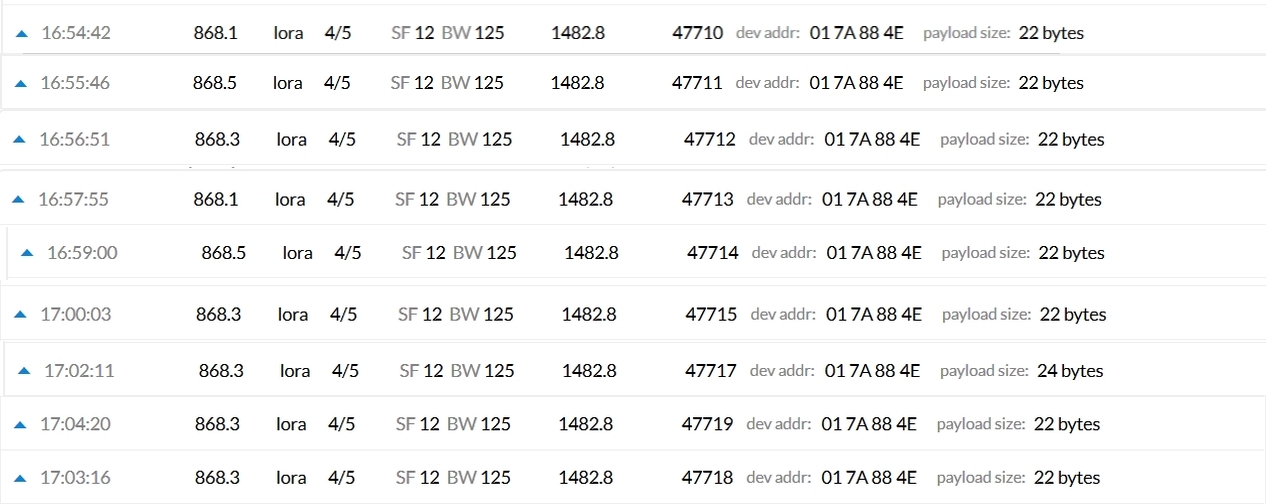(Click to see the JavaScript used to generate the above list)
let items = [
[0, 'Local', 'Experimental nodes'],
[1, 'Local', 'Experimental nodes'],
[2, 'World', 'Actility'],
[3, 'Europe', 'Proximus'],
[4, 'Europe', 'Swisscom'],
[5, 'Singapore, indonesia , Australia, Africa , India', 'SingTel'],
[6, 'Europe', 'La Poste'],
[7, 'Europe', 'Bouygues Telecom'],
[8, 'World', 'Orbiwise'],
[9, 'U.S', 'SENET'],
[10, 'Europe', 'KPN'],
[11, 'Russia', 'EveryNet'],
[12, 'Africa', 'FastNet'],
[13, 'World', 'SK Telecom'],
[14, 'World', 'SagemCom'],
[15, 'Europe', 'Orange France'],
[16, 'Italy', 'A2A Smart City'],
[17, 'India, Sri Lanka, Nepal, Bangladesh and the Maldives Islands', 'TATA Communication'],
[18, 'World', 'Kerlink'],
[19, 'World', 'The Things Network'],
[20, 'Germany, Switzerland, China', 'DIGIMONDO GmbH'],
[21, 'World', 'Cisco Systems'],
[22, 'China', 'Computer Network Information Center & Chinese of Sciences Guangzhou Sub-center (CNIC)'],
[23, 'World', 'MultiTech Systems'],
[24, 'World', 'Loriot'],
[25, 'World', 'NNNCo'],
[26, 'World', 'Flashnet'],
[27, 'World', 'TrackNet'],
[28, 'World', 'Lar.Tech'],
[29, 'World', 'Swiss Led'],
[30, 'CIS, Europe', 'Net868'],
[31, 'Italy', 'Axatel'],
[32, 'Germany', 'Telent (Netzikon)'],
[33, 'World', 'Patavina Technologies'],
[34, 'North America', 'Comcast'],
[35, 'Australia, New Zealand', 'Ventia'],
[36, 'World', 'Gimasi'],
[37, 'World', 'Talkpool'],
[38, 'Italy', 'Telemar'],
[39, 'World', 'MCF88 SRL'],
[40, 'Malaysia', 'VADSLYFE'],
[41, 'World', 'GIoT'],
[42, 'World', 'M2B Communications'],
[43, 'China', 'ZTE'],
[44, 'Australia', 'Airlora'],
[45, 'World', 'Rai Way'],
[46, 'World', 'Levikom'],
[47, 'South Africa', 'Comsol Networks'],
[48, 'World', 'SoftBank'],
[49, 'World', 'Inmarsat']
];
function hex(val, len=2) {
return ('0'.repeat(len) + val.toString(16)).substr(-len);
}
console.info('> _NetID, DevAddr MSB, location(s): name_');
console.info('>');
for (let [netId, location, name] of items) {
// nwkId = 7 LSB of NetID:
let nwkId = netId & 0b01111111;
// ...and nwkId = 7 MSB of DevAddr:
let devAddr = nwkId << 1;
console.info(`> - \`0x${hex(netId)}\`, \`0x${hex(devAddr)}/${hex(devAddr+1)}\`, ${location}: ${name}`);
}

